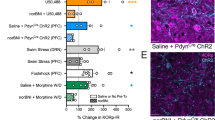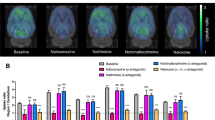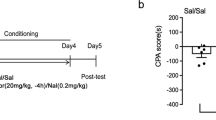Abstract
Previous studies have identified potential antidepressant effects of buprenorphine (BPN), a drug with high affinity for mu opioid receptor (MORs) and kappa opioid receptors (KORs) and some affinity at delta opioid receptor (DOR) and opioid receptor-like 1 (ORL-1) receptors. Therefore, these studies examined which opioid receptors were involved in BPN’s effects on animal behavior tests sensitive to antidepressant drugs. The acute effects of BPN were tested in the forced swim test (FST) using mice with genetic deletion of individual opioid receptors or after pharmacological blockade of receptors. For evaluating the effects of BPN on chronic stress, separate groups of mice were exposed to unpredictable chronic mild stress (UCMS) for 3 weeks and treated with BPN for at least 7 days before behavioral assessment and subsequent measurement of Oprk1, Oprm1, and Pdyn mRNA expression in multiple brain regions. BPN did not reduce immobility in mice with KOR deletion or after pretreatment with norbinaltorphimine, even though desipramine remained effective. In contrast, BPN reduced immobility in MOR and DOR knockout mice and in mice pretreated with the ORL-1 antagonist JTC-801. UCMS reduced sucrose preference, decreased time in the light side of the light/dark box, increased immobility in the FST and induced region-specific alterations in Oprk1, Oprm1, and PDYN mRNA expression in the frontal cortex and striatum. All of these changes were normalized following BPN treatment. The KOR was identified as a key player mediating the effects of BPN in tests sensitive to antidepressant drugs in mice. These studies support further development of BPN as a novel antidepressant.
Similar content being viewed by others
Log in or create a free account to read this content
Gain free access to this article, as well as selected content from this journal and more on nature.com
or
References
Almatroudi A, Husbands SM, Bailey CP, Bailey SJ (2015). Combined administration of buprenorphine and naltrexone produces antidepressant-like effects in mice. J Psychopharmacol 29: 812–821.
Balu DT, Hodes GE, Anderson BT, Lucki I (2009). Enhanced sensitivity of the MRL/MpJ mouse to the neuroplastic and behavioral effects of chronic antidepressant treatments. Neuropsychopharmacology 34: 1764–1773.
Bodkin JA, Zornberg GL, Lukas SE, Cole JO (1995). Buprenorphine treatment of refractory depression. Clin Psychopharmacology 15: 49–57.
Browne CA, van Nest DS, Lucki I (2015). Antidepressant-like effects of buprenorphine in rats are strain dependent. Behav Brain Res 278C: 385–392.
Carlezon WA Jr., Beguin C, DiNieri JA, Baumann MH, Richards MR, Todtenkopf MS et al (2006). Depressive-like effects of the kappa-opioid receptor agonist salvinorin A on behavior and neurochemistry in rats. J Pharmacol Exp Ther 316: 440–447.
Carr GV, Bangasser DA, Bethea T, Young M, Valentino RJ, Lucki I (2010). Antidepressant-like effects of kappa-opioid receptor antagonists in Wistar Kyoto rats. Neuropsychopharmacology 35: 752–763.
Cowan A (2007). Buprenorphine: the basic pharmacology revisited. J Addict Med 1: 68–72.
Delaney G, Dawe KL, Hogan R, Hunjan T, Roper J, Hazell G et al (2012). Role of nociceptin/orphanin FQ and NOP receptors in the response to acute and repeated restraint stress in rats. J Neuroendocrinol 24: 1527–1541.
Ehrich E, Turncliff R, Du Y, Leigh-Pemberton R, Fernandez E, Jones R et al (2015). Evaluation of opioid modulation in major depressive disorder. Neuropsychopharmacology 40: 1448–1455.
Falcon E, Maier K, Robinson SA, Hill-Smith TE, Lucki I (2015). Effects of buprenorphine on behavioral tests for antidepressant and anxiolytic drugs in mice. Psychopharmacology 232: 907–915.
Filliol D, Ghozland S, Chluba J, Martin M, Matthes HW, Simonin F et al (2000). Mice deficient for delta- and mu-opioid receptors exhibit opposing alterations of emotional responses. Nat Genet 25: 195–200.
Hurd YL, Herman MM, Hyde TM, Bigelow LB, Weinberger DR, Kleinman JE (1997). Prodynorphin mRNA expression is increased in the patch vs matrix compartment of the caudate nucleus in suicide subjects. Mol Psychiatry 2: 495–500.
Ipser JC, Terburg D, Syal S, Phillips N, Solms M, Panksepp J et al (2013). Reduced fear-recognition sensitivity following acute buprenorphine administration in healthy volunteers. Psychoneuroendocrinology 38: 166–170.
Karp JF, Butters MA, Begley AE, Miller MD, Lenze EJ, Blumberger DM et al (2014). Safety, tolerability, and clinical effect of low-dose buprenorphine for treatment-resistant depression in midlife and older adults. J Clin Psychiatry 75: e785–e793.
Kennedy SE, Koeppe RA, Young EA, Zubieta JK (2006). Dysregulation of endogenous opioid emotion regulation circuitry in major depression in women. Arch Gen Psychiatry 63: 1199–1208.
Land BB, Bruchas MR, Lemos JC, Xu M, Melief EJ, Chavkin C (2008). The dysphoric component of stress is encoded by activation of the dynorphin kappa-opioid system. J Neuroscience 28: 407–414.
Liberzon I, Zubieta JK, Fig LM, Phan KL, Koeppe RA, Taylor SF (2002). mu-Opioid receptors and limbic responses to aversive emotional stimuli. Proc Natl Acad Sci USA 99: 7084–7089.
Lucki I, Dalvi A, Mayorga AJ (2001). Sensitivity to the effects of pharmacologically selective antidepressants in different strains of mice. Psychopharmacology 155: 315–322.
Lutfy K, Cowan A (2004). Buprenorphine: a unique drug with complex pharmacology. Curr Neuropharmacol 2: 395–402.
Lutz PE, Kieffer BL (2013). Opioid receptors: distinct roles in mood disorders. Trends Neurosci 36: 195–206.
Mague SD, Pliakas AM, Todtenkopf MS, Tomasiewicz HC, Zhang Y, Stevens WC Jr. et al (2003). Antidepressant-like effects of kappa-opioid receptor antagonists in the forced swim test in rats. J Pharmacol Exp Ther 305: 323–330.
McLaughlin JP, Marton-Popovici M, Chavkin C (2003). Kappa opioid receptor antagonism and prodynorphin gene disruption block stress-induced behavioral responses. J Neuroscience 23: 5674–5683.
Mozhui K, Karlsson RM, Kash TL, Ihne J, Norcross M, Patel S et al (2010). Strain differences in stress responsivity are associated with divergent amygdala gene expression and glutamate-mediated neuronal excitability. J Neuroscience 30: 5357–5367.
Nyhuis PW, Gastpar M, Scherbaum N (2008). Opiate treatment in depression refractory to antidepressants and electroconvulsive therapy. J Clin Psychopharmacology 28: 593–595.
Pietrzak RH, Naganawa M, Huang Y, Corsi-Travali S, Zheng MQ, Stein MB et al (2014). Association of in vivo kappa-opioid receptor availability and the transdiagnostic dimensional expression of trauma-related psychopathology. JAMA Psychiatry 71: 1262–1270.
Porsolt RD, Bertin A, Jalfre M (1977). Behavioral despair in mice: a primary screening test for antidepressants. Arch Int Pharmacodyn Ther 229: 327–336.
Schmidt HD, Duman RS (2010). Peripheral BDNF produces antidepressant-like effects in cellular and behavioral models. Neuropsychopharmacology 35: 2378–2391.
Strekalova T, Steinbusch HW (2010). Measuring behavior in mice with chronic stress depression paradigm. Prog Neuropsychopharmacol Biol Psychiatry 34: 348–361.
Syal S, Ipser J, Terburg D, Solms M, Panksepp J, Malcolm-Smith S et al (2015). Improved memory for reward cues following acute buprenorphine administration in humans. Psychoneuroendocrinology 53: 10–15.
Willner P (1997). Validity, reliability and utility of the chronic mild stress model of depression: a 10-year review and evaluation. Psychopharmacology 134: 319–329.
Willner P (2005). Chronic mild stress (CMS) revisited: consistency and behavioural-neurobiological concordance in the effects of CMS. Neuropsychobiology 52: 90–110.
Witkin JM, Statnick MA, Rorick-Kehn LM, Pintar JE, Ansonoff M, Chen Y et al (2014). The biology of Nociceptin/Orphanin FQ (N/OFQ) related to obesity, stress, anxiety, mood, and drug dependence. Pharmacol Ther 141: 283–299.
Yamada H, Nakamoto H, Suzuki Y, Ito T, Aisaka K (2002). Pharmacological profiles of a novel opioid receptor-like1 (ORL(1)) receptor antagonist, JTC-801. Br J Pharmacol 135: 323–332.
Zhang Y, Simpson-Durand CD, Standifer KM (2015). Nociceptin/orphanin FQ peptide receptor antagonist JTC-801 reverses pain and anxiety symptoms in a rat model of post-traumatic stress disorder. Br J Pharmacol 172: 571–582.
Acknowledgements
We would like to acknowledge Summer Undergraduate Internship Program at the University of Pennsylvania, from which both RML and VCF received support. This research was supported by US public health services (USPHS) grants R01 MH92412, P30 DA013429 and T32 MH14654.
Author information
Authors and Affiliations
Corresponding author
Additional information
Supplementary Information accompanies the paper on the Neuropsychopharmacology website
Supplementary information
Rights and permissions
About this article
Cite this article
Falcon, E., Browne, C., Leon, R. et al. Antidepressant-like Effects of Buprenorphine are Mediated by Kappa Opioid Receptors. Neuropsychopharmacol 41, 2344–2351 (2016). https://doi.org/10.1038/npp.2016.38
Received:
Revised:
Accepted:
Published:
Issue date:
DOI: https://doi.org/10.1038/npp.2016.38
This article is cited by
-
Medical and genetic correlates of long-term buprenorphine treatment in the electronic health records
Translational Psychiatry (2024)
-
CCL2 is required for initiation but not persistence of HIV infection mediated neurocognitive disease in mice
Scientific Reports (2023)
-
Buprenorphine/naloxone versus methadone opioid rotation in patients with prescription opioid use disorder and chronic pain: study protocol for a randomized controlled trial
Addiction Science & Clinical Practice (2022)
-
Buprenorphine alters microglia and astrocytes acutely following diffuse traumatic brain injury
Scientific Reports (2021)
-
The changing opioid crisis: development, challenges and opportunities
Molecular Psychiatry (2021)



